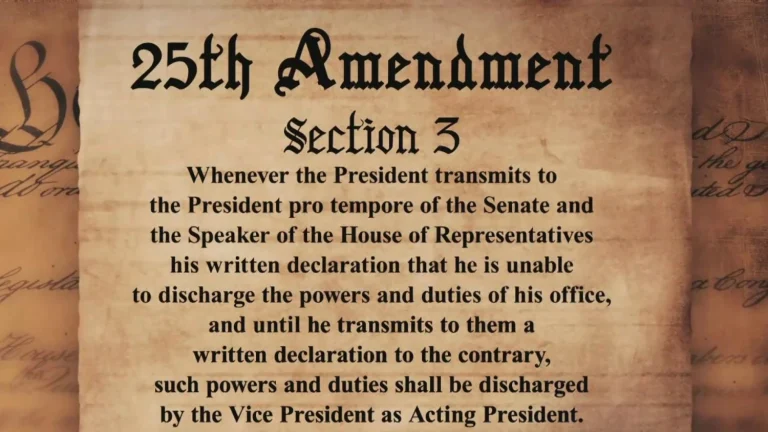25th Amendment: Everything To Know

Overview:
The Twenty-fifth Amendment, ratified in 1967, addresses presidential succession and disability. Let’s explore its key provisions:
1. Presidential Succession (Section 1):
- If the President is removed, dies, or resigns. The Vice President automatically assumes the presidency.
- This ensures a smooth transition without the need for explicit invocation.
2. Vice Presidential Vacancy (Section 2):
- When the Vice President’s office is vacant, the President nominates a new Vice President.
- Confirmation by a majority vote in both Houses of Congress is required.
3. President’s Declaration of Inability (Section 3):
- If the President declares in writing that they cannot fulfill their duties, the Vice President becomes Acting President.
- The President can later transmit a written declaration to resume their powers and duties.

History
- First Use (1973):
- The first use of the 25th Amendment occurred in 1973 when President Richard Nixon nominated Congressman Gerald R. Ford of Michigan to also fill the vacancy left by Vice President Spiro Agnew’s resignation.
- In less than a year, the 25th Amendment would be used again. This time when Vice President Ford became President after Richard Nixon resigned.
- Purpose and Context:
- Enacted on February 10, 1967, after the assassination of President John F. Kennedy in 1963, the amendment lays out rules for the transfer of power in the event of a president’s death, resignation, or incapacity.
- It addresses scenarios where the president or vice president becomes incapacitated or disabled.

Recent Controversies Related To The 25 Amendment
West Virginia Attorney General’s Letter (2024):
-
- Patrick Morrisey, West Virginia’s Attorney General, urged Vice President Kamala Harris to invoke the 25th Amendment and also remove President Biden from office.
- The basis was the Hur Report, which characterized Biden as an “elderly man with a poor memory.”
- However, invoking the 25th Amendment doesn’t lead to the President’s removal; it allows the Vice President to become the “acting” President during disability.
Section 4 Controversy:
-
- Section 4 is the most debated part of the 25th Amendment. It allows the Vice President and either the Cabinet or a body approved by Congress. To jointly agree that “the President is unable to discharge the powers and duties of his office.”
- The lack of a clear provision in Section 4 also regarding the absence of a Vice President to declare a President unable to serve adds to the controversy.
Historical Instances:
-
-
- When Ronald Reagan was shot in 1981. It wasn’t used, even though the White House physician carried a copy of the amendment.
- Bill Clinton didn’t formally put Section 3 provisions in place during knee surgery in 1997, stating he was never under general anesthesia.
-
The Twenty-fifth Amendment ensures an orderly transfer of power during critical moments. It addresses scenarios like death, removal, or incapacitation of the President or Vice President.


